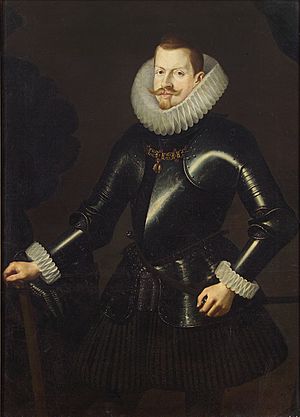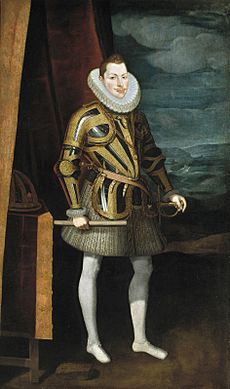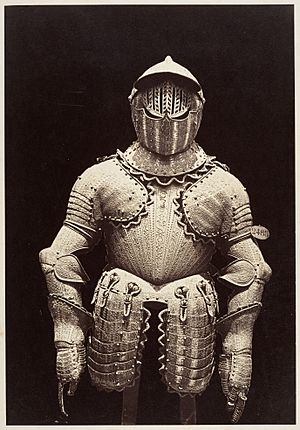Philip III of Spain facts for kids
Quick facts for kids Philip III |
|
|---|---|

Portrait by Andrés López Polanco, c. 1617
|
|
| King of Spain and Portugal (more...) | |
| Reign | 13 September 1598 – 31 March 1621 |
| Predecessor | Philip II of Spain |
| Successor | Philip IV of Spain |
| Born | 14 April 1578 Royal Alcázar of Madrid, Madrid, Spain |
| Died | 31 March 1621 (aged 42) Madrid, Spain |
| Burial | El Escorial |
| Spouse | |
| Issue |
|
| House | Habsburg |
| Father | Philip II of Spain |
| Mother | Anna of Austria |
| Religion | Roman Catholicism |
| Signature |  |
Philip III (Spanish: Felipe III; 14 April 1578 – 31 March 1621) was King of Spain. As Philip II, he was also King of Portugal, Naples, Sicily and Sardinia and Duke of Milan from 1598 until his death in 1621.
Contents
Parents
A member of the House of Habsburg, Philip III was born in Madrid to King Philip II of Spain and his fourth wife, his niece Anna, the daughter of Holy Roman Emperor Maximilian II and Maria of Spain.
Reign
Although also known in Spain as Philip the Pious, Philip's political reputation abroad has been largely negative.
Within a few hours of Philip ascending to the throne, his close friend Francisco Gómez de Sandoval, 1st Duke of Lerma had been made a royal counsellor by the new king and set about establishing himself as a fully fledged valido, or royal favourite. Lerma, in due course declared a duke, positioned himself as the gateway to the king. All the business of government, Philip instructed, was to arrive in writing and be channeled through Lerma before reaching him. Philip's reliance on his corrupt chief minister drew much criticism at the time and afterwards.
From 1612 onwards the Lerma administration was crumbling. The monopoly of power in the hands of the Lerma's Sandoval family had generated numerous enemies. Lerma's personal enrichment in office had become a scandal. Philip remained close to Lerma, however, and supported him in becoming a cardinal in March 1618 under Pope Paul V, a position which would offer Lerma some protection as his government collapsed. After Lerma departed for his ducal seat, Philip signed a decree renouncing the powers of his former valido, and announcing that he would rule in person.
Philip III's reign was marked by significant economic problems across Spain. Famine struck during the 1590s through a sequence of bad harvests, whilst from 1599 to 1600 and for several years afterwards there was a terrible outbreak of bubonic plague across Spain, killing over 10% of the population. This economically weakened the country.
Financially, Philip's situation did not appear much better. He had inherited huge debts from his father, Philip II. Philip III received no money from the cortes, or parliaments, of Aragon, the Basque provinces or Portugal; Valencia only provided one contribution, in 1604.
On his accession, Philip inherited two major conflicts from his father - the long-running Dutch revolt and the Anglo–Spanish War. After military campaigns, both wars ended in peace negotiations. The Treaty of London was signed in 1604, and the Twelve Years' Truce with the Dutch followed in 1609.
In the final years of Philip's reign, Spain entered the initial part of the conflict that would become known as the Thirty Years' War (1618–48). The result was a decisive Spanish victory in the Holy Roman Empire that would lead to a recommencement of the war with the Dutch shortly after Philip's death.
Colonial policy
In the Americas Philip inherited a difficult situation in Chile. The local Mapuche succeeded in razing seven Spanish cities (1598–1604). About 3,000 Spanish settlers killed and 500 Spanish women taken into captivity by Mapuche. In retaliation the proscription against enslaving Indians captured in war was lifted by Philip in 1608. This decree was abused when Spanish settlers in Chiloé Archipelago used it to justify slave raids against groups such as the Chono of northwestern Patagonia who had never been under Spanish rule and never rebelled.
Jesuit missionary Luis de Valdivia believed the Mapuche could be voluntarily converted to Christianity only if there was peace. To diminish hostilities Valdivia proposed a Defensive War in a letter to Philip. The king supported the idea, issuing a decree that established the Defensive War as an official policy in 1612. By the time Defensive War was established war between Spanish and Mapuche had been going on for 70 years.
These policies were not without criticism. Maestre de campo and corregidor of Concepción Santiago de Tesillo claimed the Defensive War gave the Mapuche a much needed respite to replenish their forces that should have been denied. The Real Audiencia of Santiago opined in the 1650s that slavery of Mapuches was one of the reasons for constant state of war between the Spanish and the Mapuche.
Death
Philip III died in Madrid on 31 March 1621, and was succeeded by his son, Philip IV. The story told in the memoirs of the French ambassador Bassompierre, that he was killed by the heat of a brasero (a pan of hot charcoal), because the proper official to take it away was not at hand, is a humorous exaggeration of the formal etiquette of the court.
Legacy
Philip has generally left a poor legacy with historians. Three major historians of the period have described an 'undistinguished and insignificant man', a 'miserable monarch', whose 'only virtue appeared to reside in a total absence of vice'. More generally, Philip has largely retained the reputation of 'a weak, dim-witted monarch who preferred hunting and traveling to governing'.
Family tree
Like many Habsburgs, Philip III was the product of extensive inbreeding. His father, Philip II, a product of marriage between first cousins, married his niece, Anna of Austria, herself the product of a cousin couple. Philip III in turn married his first cousin once removed, Margaret of Austria. This pattern would continue in the next generation, ultimately culminating in the end of the Spanish Habsburg line in the person of Philip's feeble grandson, Charles II.
| Ancestors of Philip III and his relationship with his wife | ||||||||||||||||||||||||||||||||||||||||||||||||||||||||||||||||||||||||||||||||||||||||||||||||||||||||||||||||||||||||||||||||||||||||||||||||||||||||||||||||||||||||||||||||||||||||||||||||||||||||||||||||||||||||||||||||||||||||||||||||||||||||||||||||||||||||||||||||||||||||||||||||||||||||||||||||||||||||||||||||||||||||||||||||||||||||||||||||||||||||||||||||||||||||||||||||||||||||||||||||||||||||||||||||||||||||||||||||||||||||||||||||||||||||||||||||||||||||||||||||||||||||||||||||||||||||||||||||||||||||||||||||||||||||||||||||||||||||
|---|---|---|---|---|---|---|---|---|---|---|---|---|---|---|---|---|---|---|---|---|---|---|---|---|---|---|---|---|---|---|---|---|---|---|---|---|---|---|---|---|---|---|---|---|---|---|---|---|---|---|---|---|---|---|---|---|---|---|---|---|---|---|---|---|---|---|---|---|---|---|---|---|---|---|---|---|---|---|---|---|---|---|---|---|---|---|---|---|---|---|---|---|---|---|---|---|---|---|---|---|---|---|---|---|---|---|---|---|---|---|---|---|---|---|---|---|---|---|---|---|---|---|---|---|---|---|---|---|---|---|---|---|---|---|---|---|---|---|---|---|---|---|---|---|---|---|---|---|---|---|---|---|---|---|---|---|---|---|---|---|---|---|---|---|---|---|---|---|---|---|---|---|---|---|---|---|---|---|---|---|---|---|---|---|---|---|---|---|---|---|---|---|---|---|---|---|---|---|---|---|---|---|---|---|---|---|---|---|---|---|---|---|---|---|---|---|---|---|---|---|---|---|---|---|---|---|---|---|---|---|---|---|---|---|---|---|---|---|---|---|---|---|---|---|---|---|---|---|---|---|---|---|---|---|---|---|---|---|---|---|---|---|---|---|---|---|---|---|---|---|---|---|---|---|---|---|---|---|---|---|---|---|---|---|---|---|---|---|---|---|---|---|---|---|---|---|---|---|---|---|---|---|---|---|---|---|---|---|---|---|---|---|---|---|---|---|---|---|---|---|---|---|---|---|---|---|---|---|---|---|---|---|---|---|---|---|---|---|---|---|---|---|---|---|---|---|---|---|---|---|---|---|---|---|---|---|---|---|---|---|---|---|---|---|---|---|---|---|---|---|---|---|---|---|---|---|---|---|---|---|---|---|---|---|---|---|---|---|---|---|---|---|---|---|---|---|---|---|---|---|---|---|---|---|---|---|---|---|---|---|---|---|---|---|---|---|---|---|---|---|---|---|---|---|---|---|---|---|---|---|---|---|---|---|---|---|---|---|---|---|---|---|---|---|---|---|---|---|---|---|---|---|---|---|---|---|---|---|---|---|---|---|---|---|---|---|---|---|---|---|---|---|---|---|---|---|---|---|---|---|---|---|---|---|---|---|---|---|---|---|---|---|---|---|---|---|---|---|---|---|---|---|---|---|---|---|---|---|---|---|---|---|---|---|---|---|---|---|---|---|---|---|---|---|---|---|---|---|---|---|---|---|---|---|---|---|---|---|---|---|---|---|---|---|---|---|---|---|---|---|---|---|
|
||||||||||||||||||||||||||||||||||||||||||||||||||||||||||||||||||||||||||||||||||||||||||||||||||||||||||||||||||||||||||||||||||||||||||||||||||||||||||||||||||||||||||||||||||||||||||||||||||||||||||||||||||||||||||||||||||||||||||||||||||||||||||||||||||||||||||||||||||||||||||||||||||||||||||||||||||||||||||||||||||||||||||||||||||||||||||||||||||||||||||||||||||||||||||||||||||||||||||||||||||||||||||||||||||||||||||||||||||||||||||||||||||||||||||||||||||||||||||||||||||||||||||||||||||||||||||||||||||||||||||||||||||||||||||||||||||||||||
| Notes: | ||||||||||||||||||||||||||||||||||||||||||||||||||||||||||||||||||||||||||||||||||||||||||||||||||||||||||||||||||||||||||||||||||||||||||||||||||||||||||||||||||||||||||||||||||||||||||||||||||||||||||||||||||||||||||||||||||||||||||||||||||||||||||||||||||||||||||||||||||||||||||||||||||||||||||||||||||||||||||||||||||||||||||||||||||||||||||||||||||||||||||||||||||||||||||||||||||||||||||||||||||||||||||||||||||||||||||||||||||||||||||||||||||||||||||||||||||||||||||||||||||||||||||||||||||||||||||||||||||||||||||||||||||||||||||||||||||||||||
Interesting facts about Philip III of Spain
- Philip was educated in Latin, French, Portuguese and astronomy, and appears to have been a competent linguist.
- However, he was not particularly intelligent or academically gifted.
- Philip III was not only a son to his father Philip, but also a grandnephew.
Images for kids
-
Francisco Goméz de Sandoval y Rojas, Duke of Lerma, Spanish statesman, Rubens
-
Ambrosio Spinola, one of Philip III's various imperial proconsuls, by Peter Paul Rubens
-
Rodrigo Calderón, executed by Philip III to satisfy the Duke of Lerma's enemies, painted by Peter Paul Rubens
-
Expulsion of the Moriscos at the port of Dénia, by Vincente Mostre
-
Mateo Alemán, an early modern novelist who recorded the terrible 'plague that came down from Castile and the famine that rose from Andalusia' to cripple Philip III's domestic economy. Engraving by Pedro Perete
-
The Somerset House Conference between English and Spanish diplomats that brought an end to the Anglo–Spanish War (1585–1604)
-
Statue of Philip III in Madrid, by Giambologna, finished by Pietro Tacca (1616).
-
Portrait by Diego Velázquez (detail)
-
The Battle of White Mountain, 1620, a triumph for the later foreign policy of Philip III
See also
 In Spanish: Felipe III de España para niños
In Spanish: Felipe III de España para niños
















